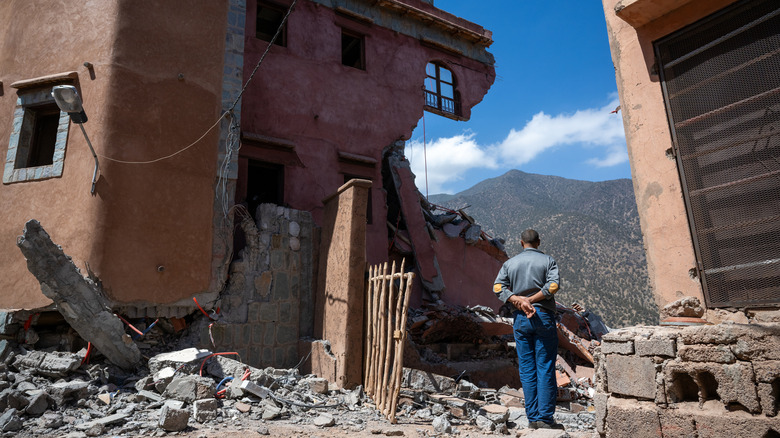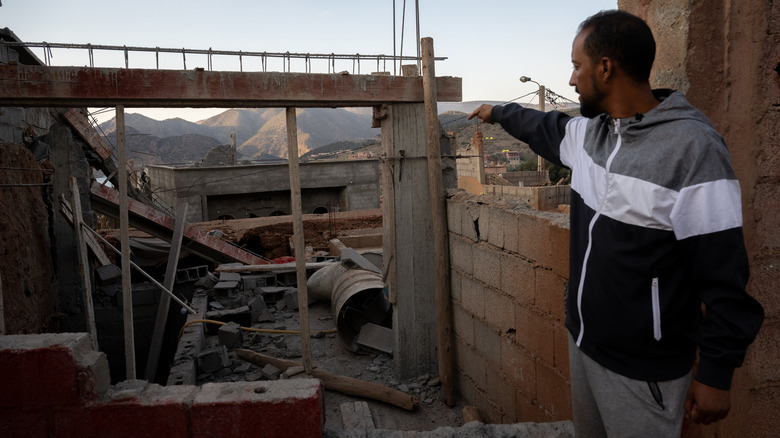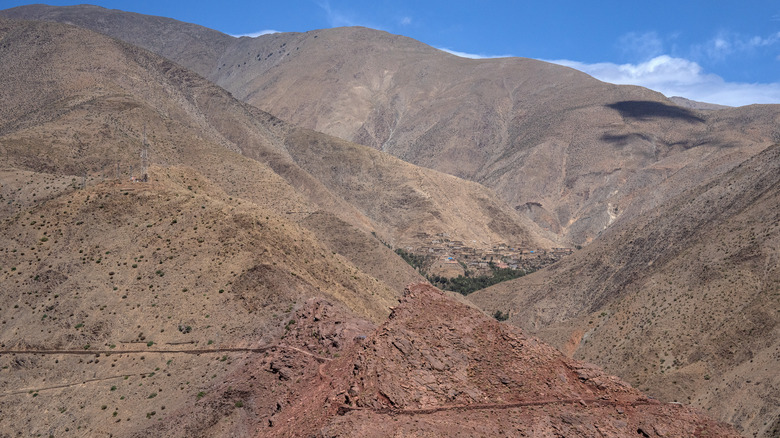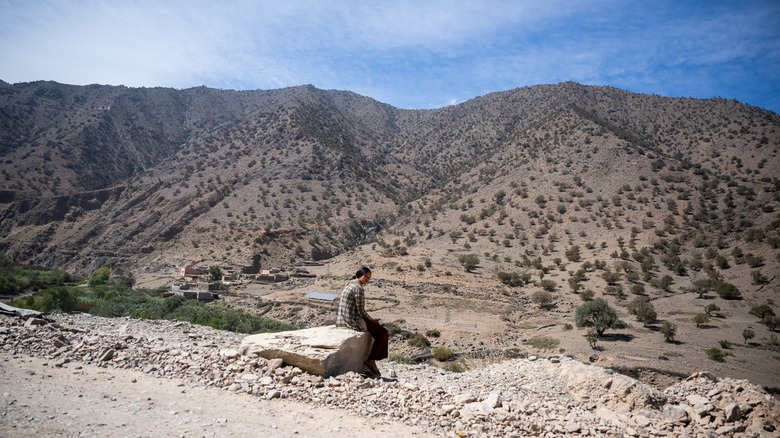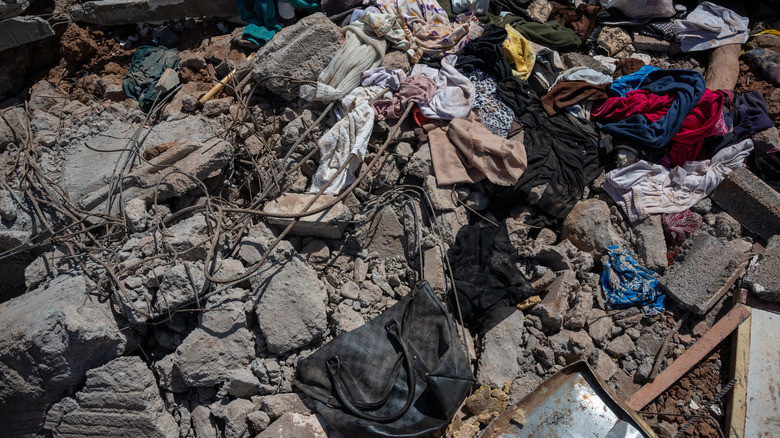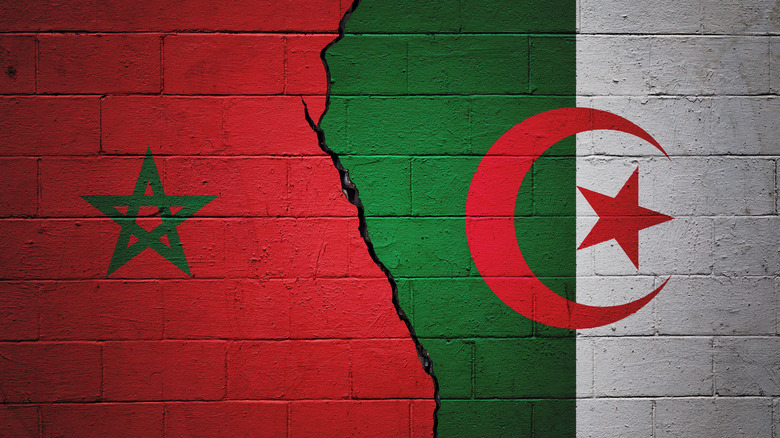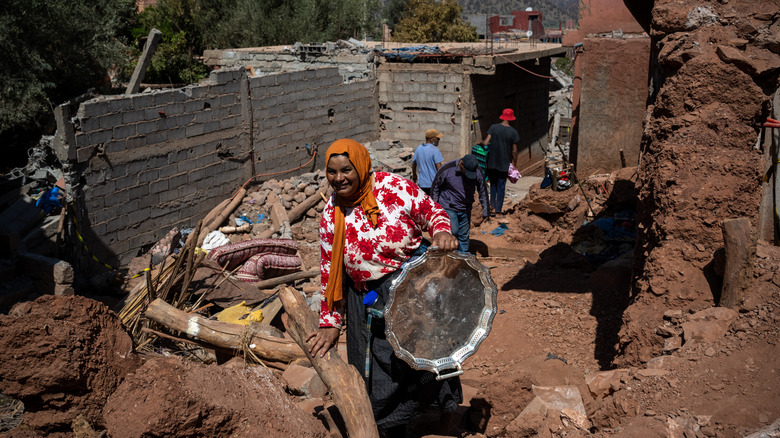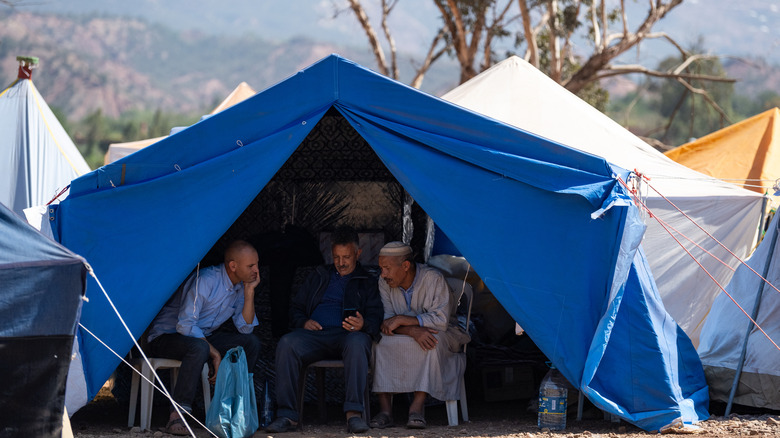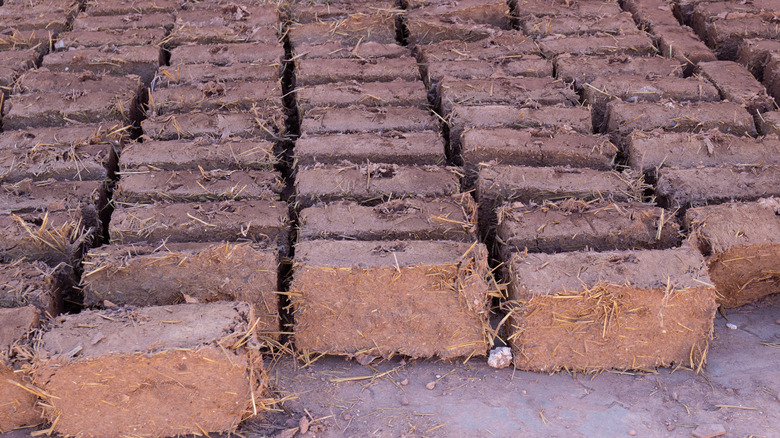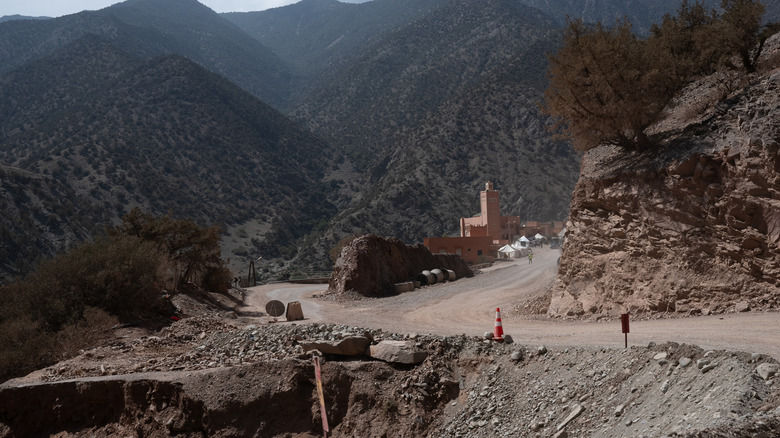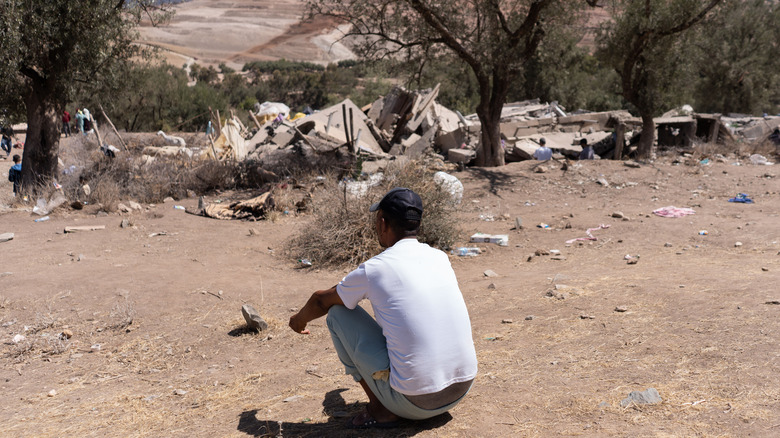The Deadly Timeline Of Morocco's 2023 Earthquake Explained
Everything can change in the blink of an eye, and in September 2023, that's precisely what happened for hundreds of thousands of people living in Morocco. The stories that started to unfold after a deadly earthquake struck the country's High Atlas Mountains were the sort of thing one might hope were the stuff of fiction, but they were all too real. Hakim Idlhousein lived in the village of Tinzert, and told CNN, "It took 10 seconds for the whole village to disappear."
That's not an exaggeration. The 300-resident village was razed to the ground, replacing streets and homes with piles of rubble. The BBC found a similar scene in the village of Tafeghaghte, where one resident told them, "People in this village are either in hospital or dead." In Moulay Brahim, there were only about 10 people capable of digging through the rubble to find survivors and, more often, the dead.
And in Adaseel, a schoolteacher — who happened to be away in Marrakech when the earthquake hit — came back to devastation and frantically started searching for her students. She told the BBC, "I went to the village and started asking about my kids: 'Where is Somaya? Where is Youssef? Where is this girl? Where is that boy?' The answer came hours later: 'They are all dead.'" All 32 children, who were between the ages of 6 and 12, were among the dead. By that time, the death toll had risen to nearly 3,000, and as they were buried, the rest of the world wondered what had happened.
Morocco has been hit by devastating earthquakes before
To understand why the earthquake that hit Morocco in 2023 was so devastating, it's worth taking a step back. According to Open University professor of planetary geosciences David Rothery (via the BBC), the area was so ill prepared for the quake because earthquakes of that magnitude don't happen there often. "There's nobody alive in the local area who experienced an earthquake as big as this, and if they're close to the epicenter the shaking would have been very intense, and buildings won't have been built to seismic resilience standards, even the modern ones."
But other parts of Morocco haven't been as lucky. The 2023 earthquake was a magnitude 6.8, and there are still people around who remember quakes more deadly than this one. The British Geological Survey's head of seismology, Brian Baptie, shared something terrifying with The Wall Street Journal, and that's the fact that more than one deadly earthquake has happened in Morocco in recent memory.
That includes a magnitude 6.3 earthquake that happened on the country's Mediterranean coast in 2004, killing more than 600 people, and a magnitude 5.9 earthquake on its Atlantic coast that killed somewhere between 12,000 and 15,000 people in 1960. Powerful earthquakes have also struck Morocco in previous centuries, including an estimated magnitude 6.7 quake in 1624.
What caused the earthquake in the first place?
The conditions that cause earthquakes don't form at the drop of a hat. Jesús Galindo-Zaldivar is a Universidad de Granada professor of geodynamics who's been studying the area around Morocco's Atlas Mountains (pictured) for a long time. He explained to The Conversation just what happened to cause 2023's devastating earthquake, and said that things really started back when Pangea broke up. That led to the initial formation of the mountains, which have been very, very slowly rising.
Galindo-Zaldivar says that the two tectonic plates that come together under the Atlas Mountains are crashing into one another at a rate of somewhere around a millimeter a year. (Other estimates suggest the rate is about 3.6 mm per year.) If that doesn't sound like much, it's not — and that's important. By comparison, the tectonic plates that make up the San Andreas fault are moving together at up to 50 mm per year, and the slow movement of the Atlas Mountains means that there's not as much earthquake activity there as there is in, say, California.
So, what happened in Morocco? Slow movement of the tectonic plates has been building up energy and pressure for a long, long time. When that kind of pressure builds up, something has to give, and it did. The sudden shift of plates caused the earthquake, inevitably followed by a series of smaller earthquakes and aftershocks that happen as the massive rocks settle in a literally earth-shattering process that could take years.
Tragedy was predicted by mysterious lights in the sky
Earthquakes of various magnitudes happen with shocking frequency. The National Earthquake Information Center estimates that the planet experiences about 55 earthquakes every day, so that's plenty of data to work with. Surely, we can predict them, right? Actually, we can't, and scientists aren't even close to working out a method to do so. But here's a weird thing: For centuries, historians have recorded the appearance of strange lights in the sky, hours or even minutes before massive earthquakes. They're rather unimaginatively called earthquake lights, and a look back through social media in the moments leading up to Morocco's devastating earthquake reveals reports of strange flashes lighting up the night sky.
Friedemann Freund is a geophysicist, and he explained to The Washington Post that the nighttime conditions leading up to Morocco's earthquake were pretty perfect for capturing the strange lights. "It would be so bright that you can read the newspaper," he explained. "If these earthquake lights happen, then this is an indication that stresses are building up, which would possibly lead to a mechanical phenomenon that we call an earthquake."
The lights come in all different colors, and researchers suspect the same electrical activity that causes them might also cause other pre-earthquake signs, like animals behaving oddly. It's believed the electrical discharges that might be responsible for the lights are caused by the same movement of tectonic plates that cause earthquakes, but scientists are still researching just how the lights and earthquakes are related, if at all.
When it hit, it was felt over hundreds of miles
The earthquake hit on Friday, September 8, at 11:11 p.m. local time. It wasn't long before news outlets were reporting on the initial facts, which included the spread of the tremors. While the epicenter was high in the Atlas Mountains, it was felt as far away as Casablanca to the north and the neighboring country of Algeria to the south. Outlets such as CNN confirmed that early reports of deaths and injuries were only going to get worse.
Aziz Taki told The Washington Post about fleeing his Marrakech home with his family, including his 93-year-old father. Getting out was just the beginning, and he recounted seeing them safely to a town square — away from the potential of collapsing buildings — and trying to help others. One neighbor staggered from his home and collapsed. "I was heartbroken. Imagine the fact that the person who is dying in front of you was once a neighbor and a friend," Taki said.
Others worried about aftershocks, and what was happening in other parts of the country. Loubna Rais spoke to The Guardian, saying that after her home in the capital city, Rabat, stopped shaking, she worried about others. Specifically, she worried for those in remote villages that don't have the infrastructure and resources available in cities such as Rabat. "It's heart-wrenching to think that there are all these people out there looking for their loved ones with very little to work with. ... People are trying to pull their own children from under the rubble."
Borders opened for the first time in a long time... maybe
The day after the earthquake devastated Morocco, their nearest neighbor reached out — and it was a big deal. Algeria not only announced they were opening air space to any aid flights on the way to Morocco, but immediately put in place plans to send relief workers, supplies, and other emergency aid. The Algerian government announced (via Al Jazeera) that they would follow through with sending "logistical and material urgent aid ... to the Moroccan people, our brothers, to face the aftermath of the violent earthquake."
While it might seem like the neighborly thing to do, it's important to remember that the two nations have been at odds for a long time, starting in earnest with a 1963 border squabble. Diplomatic relations remained iffy, land borders between the two closed in 1994, human rights protests flared, and diplomatic relations ended in 2021.
Although there was a major outpouring from Algerian citizens hoping to see fences mended, Atalayar reported that things may not have been as they seemed. As of September 13, Morocco was still refusing Algerian aid, and it's alleged that footage of Algerian rescue workers and planes loaded with supplies supposedly bound for Morocco actually depicted relief efforts meant for victims of Storm Daniel in Libya. Maghreb Intelligence claimed it was done simply "to give the impression that Algerian rescuers were ready to take off to Marrakech and participate in the search for survivors." Sources have also claimed that Algeria has refused passage to relief-effort planes attempting to fly through their airspace.
Many have been left to fend for themselves
By the day after the earthquake, the Moroccan government was mobilizing first responders and military personnel. But just as quickly, the head of the Moroccan sector of the International Federation of Red Cross and Red Crescent Societies told The New York Times that it wasn't going to be easy getting to the remote locations that were in need of the most assistance. Although much help had been offered, none could be sent — not, at least, without an official invitation from Morocco.
That was slow in coming, which all meant that in the immediate aftermath of the disaster, people were sort of left on their own to deal with things. On September 10, Al Jazeera reported that the death toll had risen to 2,012, and even in Marrakech, it was ordinary citizens who were doing a lot of the rescuing. Saida Bodchich was trapped in her home when it collapsed: "I was saved by my neighbors, who cleared the rubble with their bare hands," she said. "I am living with them in their house now because mine was completely destroyed."
Around 36 hours after the earthquake, CNN spoke with Sami Sensis, who shared that conditions in the village of Moulay Brahim were dire: "Nothing is happening, We are just waiting. They decided to do nothing. They are just telling us to be patient, making promises." Meanwhile, officials simply said that there were so many people in need that they couldn't all be the first to receive help.
Offers of aid came in, but it wasn't as easy as just accepting
The earthquake that hit Morocco affected hundreds of square miles and incredibly inhospitable terrain, so organizing relief efforts was never going to be an easy task. By September 10, the Interior Ministry announced that it would slowly and carefully accept some of the offers of aid that had come pouring in. The reason for caution? Officials stated (via CNN) that a "lack of coordination in such cases would be counterproductive."
Several nations extended offers of help, but only a few such offers were accepted. Spain, the U.K., the United Arab Emirates, and Qatar were invited in, and according to the Atlantic Council, rescue workers — including teams of search and rescue dogs — from other nations (including Italy and Senegal) were seen in photos that started making the rounds in the media. Other offers were put on the back burner, but not all countries were content with being told that their offers of aid were just going to have to wait.
The French media in particular condemned Morocco's decision to decline their aid as "silently killing their people," and "refusing humanitarian interventions at the cost of its distressed population." While the Moroccan government let it go with a blanket statement of appreciation toward everyone who had offered help and France's government called the conflict "a misplaced controversy," commentators were quick to point out that it was, after all, only in the 1950s that France agreed to return Morocco to independence.
Here's why the 2023 Morocco earthquake was so devastating
By September 15, the death toll had reached 2,946, with more than 5,600 people injured. Reuters spoke with rescue workers on the ground, and it was Antonio Nogales of Spain's United Firefighters Without Borders who summed it up like this: "The level of destruction is... absolute."
The epicenter of the earthquake and the areas around it were high up in the mountains, which meant that most of the people impacted by the worst of the quake were those living in homes built in the same way they'd been built for centuries. Walls were built with mud bricks that had been dried in the sun (pictured), and most buildings had a roof constructed with wood, reeds, and finally a layer of mud. It's a hugely practical and efficient way of building, since it provides a lot of protection from the area's notorious heat, but there's a down side, too.
Colin Taylor is a professor of earthquake engineering at the University of Bristol, and explained that not only will buildings constructed with more modern materials hold up better, but when they fall, they retain much of their shape, allowing for massive gaps in the rubble and ultimately increasing survivability. What rescue workers were finding themselves faced with in Morocco was much different: "You've basically got a pile of rocks and mud dust and that just congeals together. ... It really won't leave many pockets that you could survive in ... You're being buried underground, if you like, by all this material falling around you..."
Getting aid to those in need was difficult
Rescue efforts quickly proved exhausting. Just days in, Hossam Elsharkawi of the International Federation of Red Cross and Red Crescent Societies told the BBC that more help would be desperately needed. "The local response has done a fantastic job to date but they are exhausted on the third day and they will need that additional help," he said.
According to what French authorities from Rescuers Without Borders told The Associated Press, they could have been on-site within a day of the earthquake alert coming through. But it's entirely possible that, for the people who needed help the most, it wouldn't have mattered. Morocco's Sen. Lahcen Haddad explained that even before reaching some remote villages, there was a ton of road work that needed to be done first. "We don't need numbers. We need speedy work to get to the population. We have enough people to do that."
Most of the materials and resources that made it to the front lines and into remote villages were moved by helicopter, as the earthquake had also destroyed the roads. Even before the earthquake, many of the villages had intermittent and unreliable resources, including electricity and water. Along with challenges for rescuers, such conditions presented a new opportunity to point out how far amiss priorities had fallen. Experts from Stanford pointed out, for example, that rescue efforts may have been improved if the country's recent, $2 billion upgrade to high-speed trains had been funneled into expanding the railway into rural areas instead.
People started to talk about the long-lasting trauma
As rescue workers picked through the rubble, and as those who found their lives destroyed by the earthquake wondered how they were going to go on, mental healthcare workers started to talk about the long-lasting impact that the earthquake was going to have. U.K. science journalist Robin George Andrews explained (via The Atlantic) that an earthquake is a little different than other natural disasters: There's no warning when this invisible force will strike, and it's that invisibility that gives an earthquake an almost supernatural power.
In the week following the earthquake, RTL Today reported that front-line psychiatrists were seeing hundreds of new patients dealing with the loss of family, homes, and livelihoods, and some were trying to cope with the trauma of having been trapped in the rubble themselves. Patient stories are heartbreaking. One man explained, "I've been awake ever since, I can't fall asleep — as soon as I lie down everything comes back." According to the AFP (via The Frontier Post), a 9-year-old girl who was trapped in the rubble — and who lost her sister and both grandmothers — falls asleep and screams, "Get me out, I've fallen!"
Ripples have been felt across the world, too. The BBC reported on a spike in cases of PTSD in London, where many Moroccan residents who suffered through the deadly 2017 Grenfell Tower fire found themselves living through the worst of their symptoms yet again. Trowbridge's large Moroccan community has also been devastated. Trowbridge resident Hesham Bakali has been organizing donations and fielding phone calls from family and friends in Morocco, saying, "I can't continue my day, every day it's in my head."
